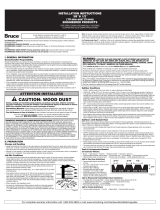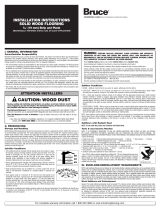
Installation Instructions
LP Legacy® Sub-Flooring
Description
• Single-layer sub-ooring designed for residential and light
commercial construction, including manufactured and
modular home applications.
• Features a self-spacing tongue and groove system that is
specially engineered to t together with ease.
• Features panel end RainChannel
®
notches that allow
trapped water to drain from oor joists.
Basic Uses
• When fastened over appropriate framing, panels provide
a structural oor deck that serves as a suitable surface
for additional framing or underlayment. When properly
installed, panels will provide a surface that is appropriate
for the direct application of carpet over pad, and of
thick wood strip or parquet ooring. Some wood ooring
manufacturers may require additional underlayment.
Consult manufacturer’s installation instructions for details.
• Panels may be used in combination with an underlayment
approved by the manufacturer to provide a surface that
is suitable for the installation of resilient tile, sheet
vinyl, or other nish ooring materials. Refer to ooring
manufacturer’s guidelines for specic information related
to the use of adhesives and proper installation details.
Limitations
• Not designed for unprotected exterior use. Exposure to
reasonable precipitation during normal construction delays
will not damage the panels. ADDITIONAL PROTECTIVE
MEASURES MAY BE NECESSARY DURING EXTENDED
EXPOSURE OR ADVERSE WEATHER CONDITIONS.
• Do not install directly over concrete or masonry.
Storage and Handling
• Store panels in clean, dry areas and off of the ground. If
possible, store indoors.
• If stored outside, cover panels with plastic sheets or tarps.
Keep cover open and away from the sides and bottom of
the panels to allow for air circulation.
• Protect edges to avoid damage to the tongue and
groove prole.
• Space units at least 4˝ on all four sides.
Before You Begin
• Before installation, allow panels to acclimate to existing
job site moisture conditions.
• Be sure to allow wet wood framing to dry before
sub-ooring installation.
• Refer to the following LP Legacy
®
sub-ooring installation
instructions or the APA’s Engineered Wood Construction
Guide Form E30W (February 2016) or the current
equivalent. To obtain installation information from the
APA, call (253) 565-6600 or visit www.apawood.org.
General Information
• Easy to handle, cut and nail. Can be routed and drilled with
standard woodworking tools.
• Fasten with conventional nailing and gluing techniques.
• Code-approved screws may be used. Refer to screw
manufacturer’s installation instructions for sub-oor
applications.
• Install panels directly over oor joists. Support joists
may be conventional solid sawn lumber, I-joists, or
manufactured trusses made of either wood or metal
chords. LP I-Joists are recommended; they are available in
depths of 9-1/2˝ to 24˝ with lengths up to 48´.
• Install panels continuously over two or more spans with
long dimension or strength axis across supports.
• Panels must be installed with APA
®
trademark stamp
facing down.
• Provide adequate ventilation and use ground
cover vapor retarder in crawl spaces.






